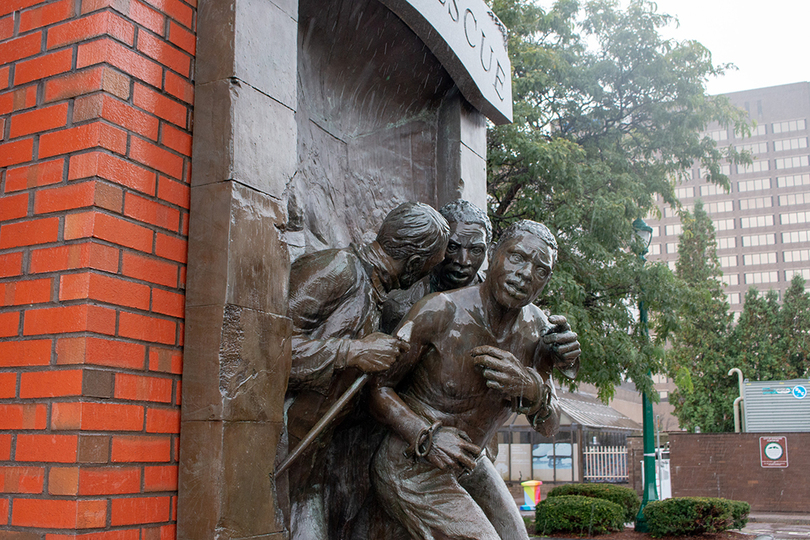171 years later, Jerry Rescue Day sparks local attention toward social change

Meghan Hendricks | Photo Editor
Memorialized as a statue in Clinton Square, the event is an “inflection point” in the history of slavery in America. The statue features Samuel May, a white abolitionist; Rev. Jermain W. Loguen, a Black man who previously escaped his own enslavement and William “Jerry” Henry.
Get the latest Syracuse news delivered right to your inbox.
Subscribe to our newsletter here.
In 1851, Syracuse residents rescued William “Jerry” Henry from being captured after he escaped slavery. Nearly 171 years later, “Jerry Rescue Day” is still memorialized in Syracuse every year on Oct. 1.
Henry was able to escape slavery in Missouri in 1850 with the help of abolitionists and local citizens, eventually making his way to Syracuse where he worked as a cooper making barrels in Clinton Square. On Oct. 1, 1851, federal marshals captured and arrested Henry, said Robert Searing, the curator of history at the Onondaga Historical Association.
“It was not only an act of resistance but also an act of hope, of the world they were hoping to come,” said Rev. Dr. Eric Jackson, acting NAACP Syracuse branch president and a local pastor. “(A world) where people born on the continent of Africa and living in America would not be enslaved and be treated by equal citizens and not judged by the color of their skin.”
Henry was taken into a hearing that would decide whether he would be moved back to Missouri. While the hearing was happening, hundreds of activists and abolitionists gathered in Clinton Square for a Liberty Party convention, the first national political party to call for the abolition of slavery, Searing said.
Henry tried to escape his arrest but failed, prompting the abolitionists in the city to plan another escape. Abolitionist sentiments were growing in Syracuse at the time, allowing for citizens to mobilize and help individuals escape slavery, Searing said.
The crowd in Clinton Square had grown to about 3,000 by the evening, consisting both of abolitionists and people who wanted to abide by the Fugitive Slave Act of 1850, Searing said. The law required enslaved people to be returned to their owners if they escaped or were freed.
“(Jerry Rescue) certainly is a major inflection point in what becomes a very divisive and heated sectional controversy, which ultimately results in the Civil War outbreak in 1861,” Searing said. “It is an event that is a lightning rod for controversy.”
At the ring of a church bell, abolitionists stormed where Henry was being held in Clinton Square. Henry then hid in a non-abolitionist’s home for days until abolitionists helped him travel to Kingston, Canada. After crossing the border, he was a free man.
It was not only an act of resistance but also an act of hope, of the world they were hoping to comeEric Jackson, vice president and acting branch president at the NAACP
Joan Bryant, an associate professor of African American Studies at Syracuse University, said “being free” as a Black person in the 1850s came with restrictions, even in states such as New York.
“No matter where someone who was legally enslaved went, even if they escaped to the free north, they were not safe,” Bryant said. “That’s one of the things that raised the ire of some people, that there was no space where slavery didn’t control.”
Jackson, who is also a pastor at Plymouth Congregational Church, said there was no “easy pipeline” toward social and political mobility for enslaved people who had escaped.
“I think (escaping slavery and living freely) took a lot of courage. It took a lot of willpower. It took a lot of bravery,” said Jackson. “I think it was also scary, because many of the people in the community who had restitutional, economic and social power, certainly did not know that.”
Leading up to the Civil War, Syracuse was known as the “Grand Central Depot of the Underground Railroad” where enslaved people could escape to and try to be free, Searing said.
But the federal government continued to put itself on the side of slavery, Bryant said. The fact that people would go after those who escaped slavery exemplifies attitudes toward claims to “property” at the time, she said.
“It says something about the complicated emotions surrounding people’s views on owning human beings, that someone would help this particular person become free but wouldn’t take a stand against slavery itself,” Bryant said.
Rescues like Henry’s brought more attention to tensions between the local community and federal law under the Fugitive Slave Act, Bryant said, revealing that state and local activism could challenge federal law.
The Jerry Rescue Day monument in Clinton Square, created in 2001, displays Henry alongside two community members who helped him escape: Samuel May, a white abolitionist and women’s rights advocate, and Rev. Jermain W. Loguen, a Black man who previously escaped his own enslavement, Searing said.
Searing believes the monument symbolizes reform and civil resistance.
“It’s a beautiful piece of public art that depicts an incredible act of civil and a resistance in the face of what people considered to be a law that was simply immoral and unconscionable,” Searing said.
Jackson also explained how the monument stands as a piece of history to remind the Syracuse community of their collective impact.
“Monuments matter because they, in a lot of ways, tell the story of what a community really values,” Jackson said. “It’s important for not only that generation who engaged in the work, but also for generations to come for eternity.”





